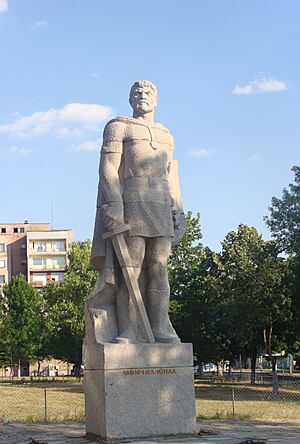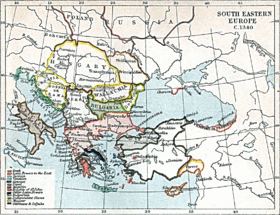Momchil facts for kids
Quick facts for kids
Momchil
|
|
|---|---|

Monument to Momchil in Momchilgrad, Bulgaria
|
|
| Born | c. 1305 |
| Died | 7 July 1345 Peritheorion
|
| Occupation | Brigand, military leader |
| Known for | Quasi-independent lord in the Rhodope area, 1343–1345 |
| Title | sebastokratōr |
| Military career | |
| Allegiance | |
| Years of service | 1341–1344 |
| Battles/wars |
|
Momchil (Bulgarian: Момчил, Greek: Μομ[ι]τζίλος or Μομιτζίλας, Serbian: Момчило / Momčilo; c. 1305 – 7 July 1345) was a brave and clever 14th-century Bulgarian leader. He started out as a member of a group of bandits, also known as hajduks, who operated in the border areas between Bulgaria, Byzantium, and Serbia. Momchil later became a soldier for hire, called a mercenary, for the Byzantine Empire.
He became very important during the Byzantine civil war of 1341–1347, a big fight for control of the Byzantine Empire. Momchil was smart and played different sides against each other. This helped him become the ruler of a large area in the Rhodopes and western Thrace. He had some early victories against Turkish forces and even almost captured one of his main opponents, John VI Kantakouzenos. However, he was eventually defeated and killed by a combined Byzantine and Turkish army in 1345. Because he fought against the Turks, many people in the South Slavic region remember him as a hero who stood up against the Turkish invasion of the Balkans.
Contents
Momchil's Early Life and Rise to Power
People who lived at the same time as Momchil said he was very tall and strong, "as tall as two men." One Turkish poet even said he looked like a minaret, which is a tall tower. Momchil was likely born in the border region between Bulgarians and Serbs, which included the Rhodopes and Pirin mountains. His name was very popular in that area, which supports this idea.
Momchil came from a humble background, meaning his family was not rich or powerful. This led him to join a group of bandits. These groups were common in the border areas where there wasn't much government control.
The Bulgarian authorities didn't like Momchil's bandit activities. So, before 1341, he fled to Byzantium. The Byzantine Emperor Andronikos III Palaiologos (who ruled from 1328 to 1341) hired Momchil as a mercenary. His job was to protect the very areas he used to raid! But Momchil didn't stop his old habits. He kept raiding Bulgarian lands, which caused problems between Byzantium and Bulgaria. Because he was disliked by both sides, he left the Byzantine army and went to Serbia. There, he joined the ruler Stephen Dušan and formed his own group of 2,000 trusted men, both Bulgarians and Serbs.
Momchil's Role in the Byzantine Civil War
During the Byzantine civil war of 1341–1347, Momchil joined the forces of John VI Kantakouzenos (who ruled from 1341 to 1354). Kantakouzenos might have met Momchil when he fled to Serbia in 1342. In 1343, the local people in the Merope region of the Rhodope Mountains wanted Momchil to be their leader. This area was a "no man's land" with many bandit groups.
Kantakouzenos agreed to make Momchil the governor of Merope. He believed Momchil, being from the same background as the local people, would be good at controlling them. Kantakouzenos also knew Momchil was brave and skilled in fighting. As governor, Momchil built an army of 300 horsemen and 5,000 foot soldiers from different groups. He felt strong enough to fight against anyone in the Byzantine war. Still, he helped Kantakouzenos in his campaigns in 1344, working with Turkish forces led by Umur Bey.

At this time, Momchil was contacted by people from the other side of the war, the government in Constantinople. They convinced him to turn against Kantakouzenos. Thinking Kantakouzenos and his Turkish allies were far away, Momchil attacked a Turkish fleet of 15 ships near Portolagos and sank three of them. He then defeated another Turkish force near the fortress of Peritheorion (also called Burugrad). He also took control of several cities in the area that refused to surrender.
After these victories, Momchil and 1,000 horsemen attacked Kantakouzenos, who had only 60 horsemen with him near Komotini. Kantakouzenos's forces were completely defeated. His horse was killed, and he was hit hard on the head, but his helmet saved him. Momchil captured many of Kantakouzenos's men, but Kantakouzenos himself managed to escape.
Soon after, Momchil sent messages to Kantakouzenos, asking for forgiveness. Kantakouzenos didn't want to make Momchil an enemy and create problems behind his lines. So, he forgave Momchil in exchange for promises of good behavior. He even gave Momchil the important title of sebastokrator. However, Momchil secretly kept in touch with the Constantinople government and even got another high title, despotes, from Empress Anna of Savoy.
Momchil Becomes an Independent Ruler
In the summer of 1344, Momchil finally decided to break away from both sides. He declared himself an independent ruler in the Rhodopes and along the Aegean coast. He was "capturing cities and villages and appearing all-powerful and invincible." He made Xanthi the capital of his new domain. Some historians believe Momchil was friendly with the Bulgarian emperor Ivan Alexander (who ruled from 1331 to 1371). They shared a long border and might have worked together against the Byzantines.
The Final Battle and Momchil's Death

In late spring 1345, Kantakouzenos, now with a large army of about 20,000 troops from Aydin led by Umur Bey, marched against Momchil. Momchil tried to stop them by asking for forgiveness again and offering to surrender to Kantakouzenos. But the emperor refused to listen this time.
The two armies met near Peritheorion on 7 July 1345. Momchil tried to find safety behind the city's walls. However, the people inside the city closed the gates against him and his men. They did let in Momchil's cousin Rayko and 50 men. They hoped this would stop Momchil from taking revenge on the city if he won. In the battle that followed, Momchil's forces used the ruined old fortifications of Peritheorion as their first line of defense, with the city walls behind them.
After the first Turkish troops crossed the fortifications and fought the Bulgarian defenders, they started taking things from the area. But to the surprise of Kantakouzenos and Umur Bey, most of Momchil's men were still standing in front of the city walls and hadn't joined the fight yet. As the Byzantine-Turkish army moved towards them, Momchil led his troops forward into battle. His horsemen were quickly defeated by Turkish archers. His remaining soldiers were surrounded on three sides by heavily armed horsemen. Momchil's men kept fighting on foot and mostly did not give up until Momchil himself was killed.
Out of respect for Momchil, Kantakouzenos did not harm Momchil's wife. She was a Bulgarian woman he had captured when he took Xanthi. Kantakouzenos allowed her to return to Bulgaria with all her belongings. It is not known if Momchil had any children.
Legacy
Momchil is remembered in popular stories and legends in the South Slavic region. He is seen as a brave fighter who stood up against the Turkish invasion of the Balkans. His story shows his courage and his cleverness in a time of great change and conflict.


